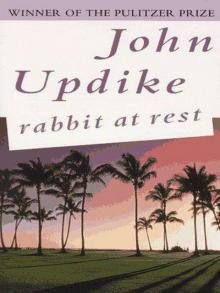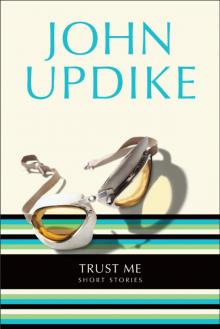- Home
- John Updike
Odd Jobs: Essays and Criticism Page 9
Odd Jobs: Essays and Criticism Read online
Page 9
I heard the rain beginning at my back as I sat at one of those late dinner parties (we sat down at ten) with which the Manhattan rich prove their fortitude. The rain made a lyrical sound, ticking off the fire escapes and deepening the swish of cars on the street far below and forming a soothing undercurrent to the name-dropping and scarcely veiled financial bragging and media exegesis. (I am struck by how seriously—religiously, indeed—New Yorkers watch television. In other parts of the country, television is taken as an escape from reality; in New York, all things being relative, it is considered a window into reality, and no doubt its phantoms do have more substance than the doormen downstairs, and the neighbors behind the apartment wall, and the mugger waiting around the corner.) Rain in New York seems to arrive from so great a distance, picking its way through so many intervening obstacles, as to be a friend bearing a private message. But the next day, having allowed plenty of time to reach my appointment, I found my host’s doorman overwhelmed with taxi requests on an avenue of cabs already taken, hurrying heedlessly past with their doused FOR HIRE lights. In the meantime, I and several other mature citizens who had miles to go and promises to keep tiptoed among the rivers that ran under the canopy and watched the minutes pour by. As frequently (but not inevitably) happens, a few empty cabs did at last wink into view and, as grateful as elderly Eskimos who at the last minute were not abandoned to starve in the snowfields, we were damply bundled off to our destinations, shedding tips like dandruff.
But at the end of my day, spent at an anachronistic ceremony held at a site, on West 155th Street, where no taxi-driver believes you want to go if you’re white, the rain had intensified, and the taxi dearth was complete; I found myself up to my ankles in a babbling gutter, waving at ships that passed in the night and thinking that my best option might be painlessly to drown. As luck would have it, in this town of hairbreadth rescues, a limousine at loose ends offered me a ride to the airport for (the driver was very clear) “thirty-five dollars—cash.” Beggars can’t be choosers, and drowning exiles can’t be thrifty, and so off we went, weaving jubilantly, only to bog down in a solid hour of stop-and-go traffic on 125th Street and another hour of trying to nudge our way onto the Triboro Bridge. The escape routes from the city were all but impenetrably jammed, and, reaching the airport, where planes not uncommonly sit on the runway for six hours waiting for their turn to fly, I tipped my driver, who had become my comrade in misery, five dollars. In his agitation at wasting so much of his time on me, he had cracked the taillight of another auto, whose protesting driver, a young Hispanic, he silenced by offering to trade insurance-company names. He knew, he explained confidentially to me, that his victim’s car would be uninsured, illegally. Thus the have-nots get their taillights raped. The little incident, one no doubt of a thousand bits of preëmptory maneuver in that hour of urban squeeze, saddened me, but instead of standing up for justice I sat back for greater ease, in the only transportation the rain-soaked jungle seemed likely to provide.
The emergency atmosphere of this most recent visit is typical, and by no means as bad as it can get: I have not yet been mugged, knocked down by a bicycling messenger, crushed by a falling construction crane, or poisoned by a handcart hot dog. The few friends of mine still toughing it out in the city assure me that such inconveniences scarcely threaten residents, who have their cozy digs, their settled ways, their familiar routes and haunts, their terms of accommodation with the state of nature. Of course I remember how one does, over the weeks and months, pull a kind of friendly village—grocery store, newsstand, flower shop, laundry, dentist—out of New York’s ghastly plenitude, its inexhaustible and endlessly repeated urban muchness. But the friendliness lies more in our wishing it to be so than in any confirming reality; returning only a little later, one finds the shops have changed names, the chummy clerks are gone, and one’s name has been erased from the computer.
Toward the end of each of my by now countless trips to New York, I must still fight a rising panic that I won’t be able to get out. The city, like the Soviet Union, has this constant usefulness: it makes you glad you live somewhere else. As in the Soviet Union, nothing is easy: there are lines at the bank and the post office, there is nowhere to park, everything is an exhausting walk away, the restaurant has no tables, the theatre has no seats, and carbon monoxide ubiquitously offers an invitation to succumb. Time has only strengthened my impelling perception of thirty years ago: being in New York takes so much energy as to leave none for any other kind of being.
A Sense of Transparency
MOST AMERICANS haven’t had my happy experience of living for thirteen years in a seventeenth-century house, since most of America lacks seventeenth-century houses. But not New England, and especially not Ipswich, Massachusetts, which, thanks to an early boom and a long stagnation, has more so-called seventeenth-century houses still standing than any other town in the nation. “So-called” because old wooden houses aren’t simple to date: the early Yankees, thrifty and handy, reused and transposed major worked timbers without any consideration for the antiquarians of the future. A noble chamfered summer beam, for instance, may certainly date from before 1680, but be worked in with structural members from several decades later, in a room with raised-field panelling from 1750, in a house fitted with new windows and staircases in the nineteenth century, and most recently clapboarded in 1950. The old frameworks were sometimes completely swallowed in later renovations, and the original shape of the place was detectable only in the attic and around the cellar stairs. The foundation itself may have belonged to an earlier, quite vanished house. Architectural historians use the term “first-period,” signifying a date before 1720. The house I and my wife and four children lived in was called, on a plaque beside the front door, the Polly Dole House and given a date of 1686, though one visiting expert sneeringly said that dating it prior to 1725 would compromise his integrity.
A seventeenth-century house can be recognized by its steep roof, massive central chimney, and utter porchlessness. Some of these houses have a second-story overhang, emphasizing their medieval look. The gables are on the sides. The windows were originally small, with fixed casements and leaded diamond panes. The basic plan called for two rooms over two, the fireplace opening into each room; a later plan added half-rooms behind, creating the traditional “saltbox” shape. Inside the front door—at least our front door—a shallow front hall gave onto an exiguous staircase squeezed into the space left by the great brick core at the heart of the house. The fireplace, with its cast-iron spits and recessed bake ovens, had been the kitchen. The virgin forests of the New World had contributed massive timbers, adzed into shape and mortise-and-tenoned together, and floorboards as much as a foot wide.
The Polly Dole House had a living room so large that people supposed the house had originally been an inn, on the winding old road to Newburyport, which ran right by. Polly Dole was a shadowy lady who may have waited on tables; we never found out much about her, though local eyebrows still lifted at her name. The big room, with its gorgeous floorboards, was one you sailed through, and the furniture never stayed in any one place. The walk-in fireplace, when the three-foot logs in it got going, singed your eyebrows and dried out the joints of any chair drawn up too cozily close. In the middle of the summer beam, a huge nut and washer terminated a long steel rod that went up to a triangular arrangement of timbers in the attic; at one point in its history the house had been lifted by its own bootstraps. I used to tell my children that if we turned the nut the whole house would fall down. We never tried it.
The decade was the Sixties, my wife and I were youngish, and the house suited us just fine. It was Puritan; it was back-to-nature; it was less-is-more. A seventeenth-century house tends to be short on frills like hallways and closets; you must improvise. A previous owner had put a pipe and a pole in a small upstairs room to make a walk-in closet; fair weather or foul, I would hike from our bedroom to my clothes every morning. I discover I have no memory at all of where my wife kept hers. Perhaps
, it being the Sixties, she only needed a miniskirt and a lumberjack shirt. Our children, four of them, slept in four little rooms in a row above the long kitchen, which for a time had been two kitchens, a partition intervening. There had been only two children when we moved in, and if there had been six little rooms, we might have felt obliged to produce six little tenants. When they were awake and downstairs, the children raced around and around the central brick mass with its four fireplaces on a counterclockwise route that went front hall, living room, kitchen, dining room, front hall.
The living room, beneath its low smoky-beamed ceiling, cheerfully accepted our butterfly chairs and Danish modern and glass-and-chrome coffee table. Such austere furniture looked in tune, on the broad old boards, under the slightly sway-backed beams. The ancient house felt oddly up-to-date in its serene lack of Victorian complications. Around 1940, an Ipswich eccentric (one of many), a bachelor antiquarian whose quest for religious authenticity eventually took him from the Anglican priesthood into that of Russian Orthodoxy, had rescued the place from tenement status. At the Depression nadir of its fortunes, we were told, not only too many people had inhabited the rooms but a flock of chickens as well. The architect-priest had in his renovations installed generous, twelve-over-twelve sash-hung windows, and this fenestration dispelled any lingering gloom. One felt Puritan claustrophobia only in the cellar, among the fieldstone foundation walls, piled up without much benefit of mortar, and threaded with a worrisome inheritance of deteriorating pipes and wires. There was no sewer connection, only a cesspool in the backyard which, by the inexorable laws of hydraulics, would sometimes overflow into our kitchen sink. In the attic, as I recall, there were many loose boards, some pink fluff pretending to be insulation, a fine view over the rooftops toward the town wharf, a ramshackle TV aerial, and, in the end, tons of stacked New Yorkers.
How did inhabiting such an antique affect our lives? We joined the local historical society, for one thing. We worked up, for benefit of our fellow first-period owners, a smattering of small talk about gunstock posts, clamshell plaster, purlin-type roof construction, and original brick nogging. First-period houses, mixed in with creditable specimens of the Georgian and Federal styles, were strung up and down our street, called High at one end and East at the other. Architectural conservation was freshly in the air; Ipswich’s old houses, left for centuries to fend for themselves, were no longer being torn down and, rather, were being taken in hand and fixed up by newcomers to the town—commuters and artisans with beards, pigtails, and a regard for history. We ourselves felt part, deeply and effortlessly, of the community because we owned a piece of its past, sleeping and eating in rooms where fourteen or so previous generations had left their scuff-marks.
The straightforward, hearth-centered architecture of our house must have strengthened our family sense. Once we moved, the fact is, things fell apart. The big nut and bolt were holding us together as well. Erwin Panofsky, in his elegant monograph Gothic Architecture and Scholasticism, describes the architectural spirit of the medieval cathedrals as one of manifestatio—the principle of elucidation and continuous clarification that informs scholastic philosophy. Each rib of the ceiling vault, for example, can be followed down into the compound columns that line the nave. Abbot Suger, the first known architectural theorist of the Middle Ages, wrote of the “principle of transparency.” “And so,” Panofsky tells us, “did High Gothic architecture delimit interior volume from exterior space yet insist that it project itself, as it were, through the encompassing structure; so that, for example, the cross section of the nave can be read off from the façade.” So, too, the layout of the rooms—two above, two below—can be read off the façades of the houses the Puritans built, and a certain transparency quickens the life within. The beams are plain to see in the rooms; organic grains and irregularities animate the floors and walls; there are no hidden passageways, no cunning closets, no dumbwaiters, no cubbyholes for servants. To wake and work in such a house felt like an honor—a privileged access to the lucid spirit of the New World’s Puritan settlements.
A Short and Happy Ride
THE STRANGE EXPECTANCY that getting on any train gives us quite outshines whatever pleasurable sensations may accompany climbing into a car or onto an airplane. It is, perhaps, the threading through of train travel, the knowledge that its path is inflexibly fixed in steel and spalls and oil-soaked ties, which makes the traveller tingle; or perhaps it is the largeness and throbbing, chuffing power of the vehicle, quite disproportionate to our simple need to get from here to there, that, as with the great steamships of the pre-jet era, spikes the trip with a dash of extravagance, of holiday. One of the cherishable distinctions of the Boston area’s North Shore (as opposed to the South, whose Old Colony Railroad shut down in 1959) remains its possession, through thick and thin, of a working commuter-train.
The line, long under the management of the Boston and Maine and now part of the Massachusetts Bay Transportation Authority, has two branches, which part at Beverly. One, the Gloucester or Rockport branch, continues northeast, up the shaggy middle of Cape Ann, and ends behind a gas station in Rockport, a ten minutes’ winding, downhill walk from a public beach; the other bears due north through the coddled greenery of Wenham and Hamilton and at one time continued on past Ipswich to Newburyport and Salisbury. I was present, over twenty years ago, at a town meeting in Ipswich which debated a motion to subsidize continued train service, or else see it cease. Commuters were much a minority at that time, but the vote carried, and the Ipswich branch did not wither away, as did its continuation up the coast. Now, I believe, at a time when the automotive passageways to Boston are increasingly congested and bound to get worse as new highways and tunnels are being desperately constructed, the railroad is prized as a regional asset, as precious to the milieu as granite outcroppings, wild blueberries, and lobster boats bobbing offshore. Suave and smooth-rolling new cars made in Canada are replacing the battered Budd coaches with their fractured windows and tattered slam-back seats, and the decaying, abandoned stations are refurbished and decorated with bright metallic maps proclaiming these once-remote outposts part of the metropolitan “T.”
Nahant, a breezy square mile of pasture and cliff connected to Lynn by a thin curve of beach, was America’s first summer resort, and the Eastern Railroad by 1838 was ferrying passengers across the harbor to East Boston and thence by rail to Nahant and Salem. The rails were extended to Beverly and Ipswich and New Hampshire; in 1847 the Gloucester branch came into existence, and seven years later the ferry was rendered obsolete by an overland link, and Gloucester found itself a mere hour from Boston. Joseph Garland’s Boston’s Gold Coast reports a native of the time poetically complaining, “A hand of iron had been laid upon the bosom of Essex County.” In his own amply poetic voice, Garland describes the subsequent invasion of the Boston rich:
Sowing the merest chaff from their bank accounts among the knowing natives, they reaped mile after priceless mile a harvest of salt water farms regarded by father unto son of shrewd Yankee owners as so many worked-out birthrights that looked out on nothing more promising or profitable than the heaving emptiness of the Atlantic Ocean. The wooing and the winning, not to say the seduction, of that virginal coast between Boston Harbor and Cape Ann followed the railroad as surely as did the opening of the West.
This proto-West has by now been thoroughly won and tamed. The trains on weekdays sternly carry commuters and shoppers into the city’s dusky, well-worn North Station. On summer weekends, the cars are almost orgiastic with lightly clad city-dwellers being hauled back, coated with salt and sand and sunburn, at the end of a day by the sea. Celtics and Bruins fans have a most convenient time of it, since the arena where both teams play is physically part of the terminal. But even those who rarely take the train get something out of it—a rumor of motion, a suggestion of potential escape. The first locomotive noisily moves before six; the last sounds its whistle long after midnight. A string of crossings excitingly ding their warning bells a
nd lower their gates. Between the hourly passings, the empty tracks are strolled by schoolchildren, as shortcuts to here and there. Where the rails run west, they reflect the orange sunset; east, the pink sunrise. The tracks’ proximity, at least in the outer reaches, does not seem to depress property values. My own house, up a wooded hill, trembles when the train passes, and the effect is as of a caress, a gentle reminder, like the sight of airplane lights circling in over Massachusetts Bay toward Logan Airport, that an urban congeries lurks over the arboreal horizon.
From either terminus, at Ipswich or Rockport, the train scuds through bucolic landscape for a while, the rocks and trees permitting glimpses of Appleton Farm and the Wenham Golf Course, Lily Pond and Manchester Harbor. Then, on the fringes of Beverly, the houses irrevocably thicken, and a grit of warehouse backs and commercial outlets flies into the eyes. Beverly Station is an ambitious yellow-brick structure that now serves the public only as a restaurant. On the coldest of winter days, with the wind-chill off of the Bass River bitter beyond factoring, the commuters huddle within the doorway to the bar or else in the lee of one of the obsolete baggage-carts that decorate the platform, cemented fast. Once mounted into the train, however, passengers are greeted with a warmth so steamy as to induce instant sleep. Forthwith, there is the sudden adventure of crossing a wide estuary on a railroad bridge narrow enough to give the illusion of riding a Hovercraft. The old oil-soaked wooden bridge burned down a few years ago, and two trains trapped north of Salem for some weeks buzzed back and forth on Cape Ann, like hornets in a bottle, until they were captured and barged back to Boston. The bridge has been rebuilt in concrete.

 Picked-Up Pieces: Essays
Picked-Up Pieces: Essays Bech: A Book
Bech: A Book Roger's Version: A Novel
Roger's Version: A Novel Seek My Face
Seek My Face The Carpentered Hen
The Carpentered Hen Pigeon Feathers: And Other Stories
Pigeon Feathers: And Other Stories Rabbit Is Rich
Rabbit Is Rich The Afterlife: And Other Stories
The Afterlife: And Other Stories Rabbit at Rest
Rabbit at Rest The Witches of Eastwick
The Witches of Eastwick Gertrude and Claudius
Gertrude and Claudius Bech Is Back
Bech Is Back Hub Fans Bid Kid Adieu: John Updike on Ted Williams
Hub Fans Bid Kid Adieu: John Updike on Ted Williams Marry Me: A Romance
Marry Me: A Romance Museums and Women: And Other Stories
Museums and Women: And Other Stories My Father's Tears and Other Stories
My Father's Tears and Other Stories Collected Poems, 1953-1993
Collected Poems, 1953-1993 Trust Me: Short Stories
Trust Me: Short Stories Odd Jobs: Essays and Criticism
Odd Jobs: Essays and Criticism Rich in Russia
Rich in Russia Higher Gossip: Essays and Criticism
Higher Gossip: Essays and Criticism The Widows of Eastwick
The Widows of Eastwick In the Beauty of the Lilies
In the Beauty of the Lilies Rabbit, Run
Rabbit, Run The Early Stories: 1953-1975
The Early Stories: 1953-1975 Rabbit Redux
Rabbit Redux S.
S. Brazil
Brazil Toward the End of Time
Toward the End of Time The Centaur: A Novel
The Centaur: A Novel Assorted Prose
Assorted Prose Memories of the Ford Administration
Memories of the Ford Administration Terrorist
Terrorist Couples: A Novel
Couples: A Novel Bech at Bay
Bech at Bay The Music School: Short Stories
The Music School: Short Stories Villages
Villages S
S Roger's Version
Roger's Version Pigeon Feathers
Pigeon Feathers Higher Gossip
Higher Gossip Rabbit Redux r-2
Rabbit Redux r-2 Memories of the Ford Administration: A Novel
Memories of the Ford Administration: A Novel The Centaur
The Centaur Marry Me
Marry Me Picked-Up Pieces
Picked-Up Pieces Bech
Bech Rabbit Remembered
Rabbit Remembered Trust Me
Trust Me The Early Stories
The Early Stories Odd Jobs
Odd Jobs The Centaurus
The Centaurus The Afterlife
The Afterlife The Music School
The Music School Museums and Women
Museums and Women Couples
Couples